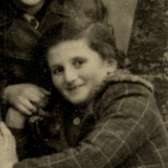
-
Learn More about Rita
- First Person Watch Rita share her Holocaust experiences at a First Person program
- Oral History Access Rita’s Oral Testimony
Rita Rubinstein was born Rifka Lifschitz on December 12, 1936, in Văscăuti, Romania (now Vashkivtsi, Ukraine) to Abraham and Tabel (née Meerbaum) Lifschitz. Her father operated a dry goods store and small factory alongside his brother-in-law. Rita was raised in a multi-generational household, which her family shared with an aunt, Abraham’s sister, and uncle and their two children, as well as with her paternal grandmother, Tzirel, and her aunt’s mother-in-law. The house was equipped with modern amenities such as electricity and a radio. Rita attended synagogue services every Shabbat alongside her father, who was an observant Jew.
Văscăuti was part of a region called Bukovina. In June 1940, the Soviet Union occupied the region in agreement with Nazi Germany. The Soviets marched into Văscăuti and, some months later, drafted young men, including Rita’s father, into its army. Rita never saw him again. A few months later, Romania joined the Axis Powers and became an ally of Nazi Germany. In summer 1941, Nazi Germany and its Axis partners, including Romania, invaded the Soviet Union. The Romanians retook Bukovina, including Văscăuti. When the Romanian soldiers entered Văscăuti, they ordered all Jews to prepare to leave in 24 hours, allowing them to take only what they could carry. In their attic, the Lifschitzes hid money and photographs. Rita’s mother bundled her up in layers and her grandmother sewed money into her own undergarments for safekeeping.
The next day Rita and her family, including her mother’s sister Bella, who had been living with them since 1940, gathered in a large building that resembled a gymnasium. From there, Romanian authorities took them to Ataki (today Otaci, Moldova) and, from there, across the Dniester River to Moghilev-Podolsk (today Mohyliv-Podilskyi, Ukraine).
Once at Moghilev, Rita’s uncle bribed Romanian soldiers with the money that Rita’s grandmother had sewn into her clothing, and the soldiers in turn took the entire family on a barge to Shargorod (Romanianized to Şargorod; today Sharhorod, Ukraine) in Transnistria.
There, a Jewish family in the village took them into their home, which had clay walls and no running water or electricity. While Rita attended a small class organized by a local teacher where she learned some Hebrew, the winters were bitterly cold and she was always hungry. Eventually, the Romanians created an open ghetto in the town, imposing strict regulations. Rita’s family remained there for three years, enduring harsh conditions, extreme deprivation, and a typhus epidemic. Rita witnessed the death of her beloved grandmother from stomach cancer.
In early 1944, Soviet troops liberated the Lifschitzes and other Jews in Transnistria. They began their journey back to Văscăuti. They were aided by two Soviet soldiers who hid them on a military train and then found a place for them to live, around the corner from their own house.
From 1945 to 1946, Rita attended a Ukrainian school in Văscăuti. During this time, she found out that her father had been killed fighting in the Soviet army. Her mother, Tabel, learned that Ukrainian neighbors had murdered her parents and siblings in their home village. Other neighbors witnessed the killings.
Eager to leave, Rita, her mother, and Bella obtained false papers stating that they were born in Poland. With these papers, they made the difficult trip from Văscăuti to Feldafing, a displaced persons camp in Germany administered by the US Army with the assistance of the American Jewish Joint Distribution Committee.
Rita contracted tuberculosis in the camp and was sent for nine months to a sanitarium, where her only consolation was her correspondence with her mother, who had stayed at Feldafing. Rita returned to the camp after she recovered and studied a range of subjects, from history and geography to math and Hebrew. Her mother married Leo Neufeld, a fellow survivor, and, in 1949, Rita, her mother, and her stepfather immigrated to the United States. They were sponsored by Bella, who had immigrated to the United States in 1947.
Rita earned a degree in education from Brooklyn College and became an elementary school teacher. In 1959, she married Nathan Rubinstein and moved to Maryland the next year. Together they had three daughters. Rita taught third grade in a public school and after their youngest daughter was born, began teaching at a Yiddish and Hebrew language religious school, where she later became principal. She was a volunteer at the United States Holocaust Memorial Museum.
